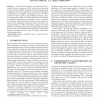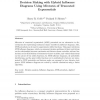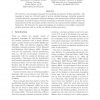63 search results - page 1 / 13 » Possibilistic Influence Diagrams |
91
Voted
ECAI
2006
Springer
15 years 4 months ago
2006
Springer
Abstract. In this article we present the framework of Possibilistic Influence Diagrams (PID), which allow to model in a compact form problems of sequential decision making under un...
EOR
2008
15 years 20 days ago
2008
Mixtures of truncated exponentials (MTE) potentials are an alternative to discretization for representing continuous chance variables in influence diagrams. Also, MTE potentials c...
107
Voted
UAI
2008
15 years 2 months ago
2008
This paper describes a new algorithm to solve the decision making problem in Influence Diagrams based on algorithms for credal networks. Decision nodes are associated to imprecise...
94
Voted
IJAR
2006
15 years 18 days ago
2006
We describe a new graphical language for specifying asymmetric decision problems. The language is based on a filtered merge of several existing languages including sequential valu...
106
click to vote
UAI
2004
15 years 2 months ago
2004
Mixtures of truncated exponentials (MTE) potentials are an alternative to discretization for representing continuous chance variables in influence diagrams. Also, MTE potentials c...



